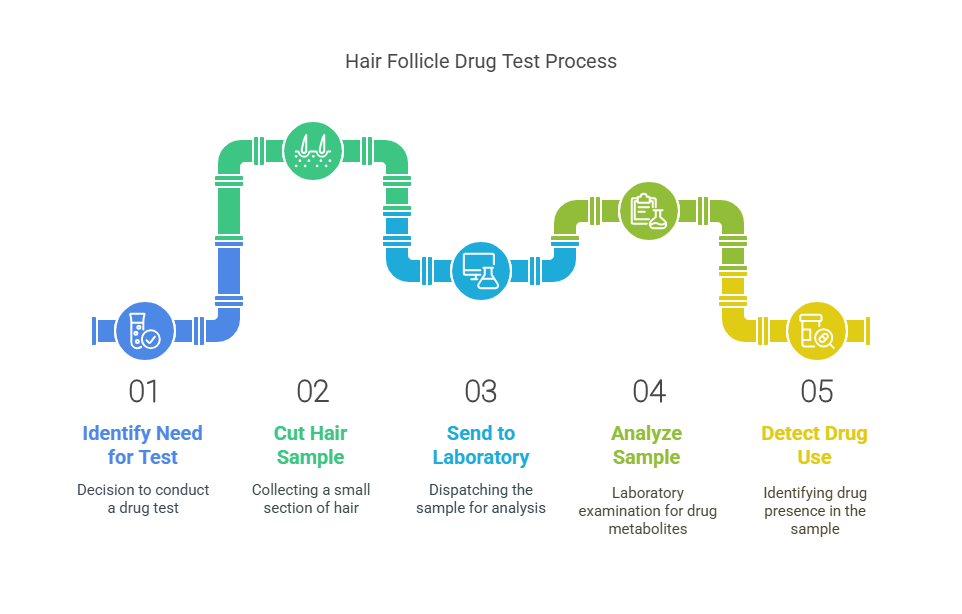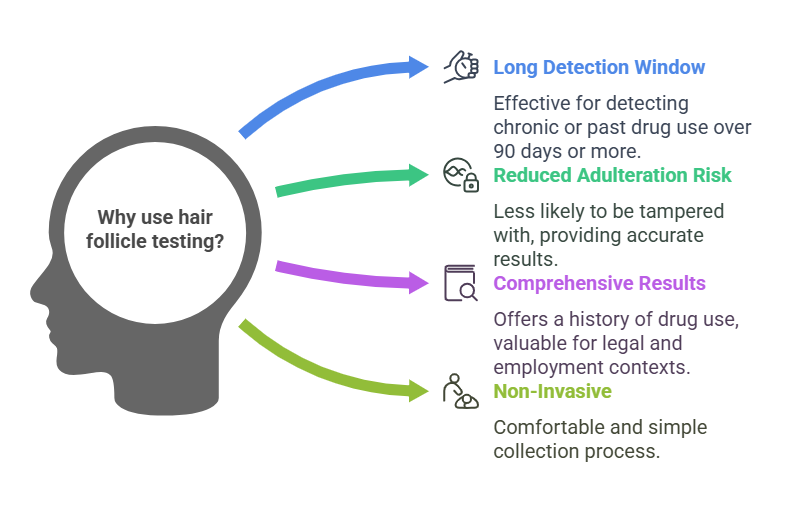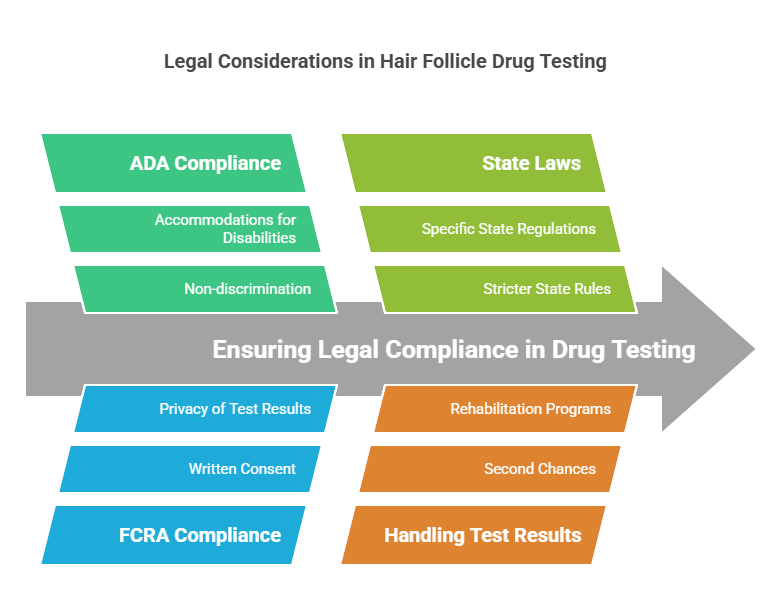How to Understand Hair Follicle Drug Testing Timelines

Introduction to Hair Follicle Drug Testing
Drug testing has become a crucial part of employment, legal proceedings, and personal health assessments. Among the various methods of drug testing, the hair follicle drug test stands out due to its ability to detect long-term drug use. This test is often preferred in situations where understanding an individual’s past drug history is essential, such as for high-security jobs, substance abuse recovery programs, or legal purposes.
In this article, we will explore how far back a hair follicle test detects drugs, its science, applications, and how it compares to other common drug testing methods like urine and saliva tests.
What is a Hair Follicle Drug Test?

A hair follicle drug test is a diagnostic method used to detect the presence of drugs in an individual’s system by analyzing a small sample of their hair. The test involves cutting a small section of hair, typically from the crown of the head, and sending it to a laboratory where it is analyzed for drug metabolites.
Unlike urine or saliva tests, which primarily detect recent drug use, hair follicle tests are effective in detecting drug use over a longer period, typically up to 90 days, depending on hair growth and the type of drug used.
How Does a Hair Follicle Drug Test Work?
When a person consumes drugs, the body metabolizes them, and the metabolites are carried in the bloodstream. As the blood circulates through the body, it reaches the hair follicles, where these metabolites become trapped in the growing hair shaft. The hair grows at an average rate of about half an inch per month, so by analyzing a segment of hair, you can gain insight into drug use over a period of time.
The test works by measuring the concentration of drug metabolites within the hair shaft, allowing laboratories to detect a history of drug use rather than just a recent exposure. This is particularly useful for employers and legal entities that require a more comprehensive understanding of an individual’s substance use history.
Why is Hair Follicle Testing Used?

Hair follicle drug testing is popular in specific scenarios where detecting long-term drug use is important. This method is preferred for the following reasons:
- Long Detection Window: Unlike urine or saliva tests that may only detect drug use within a short window (a few days to a week), hair follicle tests can identify drug use over a period of 90 days or more. This makes them highly effective for detecting chronic or past drug use.
- Reduced Risk of Adulteration: Hair samples are more difficult to tamper with compared to urine, which can be diluted or substituted with clean samples. Hair tests are less likely to be manipulated and provide a more accurate reflection of past drug use.
- Comprehensive Results: Hair follicle tests provide a history of drug use, which can be crucial for understanding whether someone has used drugs over a longer period. This is especially valuable in legal cases, employment screenings, and rehabilitation assessments.
- Non-Invasive: The process of collecting a hair sample is minimally invasive and relatively simple. It does not require the same level of privacy concerns as urine tests, making it more comfortable for individuals involved in the test.
How Far Back Does a Hair Follicle Test Detect Drugs?
One of the most frequently asked questions about hair follicle testing is: how far back can this test detect drug use? The answer typically depends on the length of the hair sample provided and the rate of hair growth. Hair typically grows about half an inch per month, meaning a 1.5-inch sample can provide a history of drug use over a three-month period (roughly 90 days).
It’s important to note that this timeframe can vary depending on factors like:
- Hair Growth Rate: Not all individuals’ hair grows at the same rate. While the average rate is about half an inch per month, some people may experience faster or slower hair growth.
- Hair Length: The length of the hair sample is a significant factor in determining how far back a test can detect drug use. A longer hair sample can provide a more extended history of drug use.
- Drug Type and Dosage: The amount and frequency of drug use can also influence the detection window. For instance, heavy or frequent drug users may have more significant traces of drugs in their hair, which could make the detection window longer.
Comparison of Different Drug Tests and Their Detection Windows
| Test Type | Detection Window | What It Detects |
|---|---|---|
| Hair Follicle Test | Up to 90 days (based on hair length) | Long-term drug use (marijuana, cocaine, opiates, methamphetamines, etc.) |
| Urine Test | 1 to 7 days | Recent drug use (primarily for drugs like marijuana, cocaine, and opiates) |
| Saliva Test | 1 to 3 days | Recent drug use (ideal for detecting immediate ingestion of drugs) |
Common Drugs Tested in a Hair Follicle Drug Test
A standard hair follicle drug test can detect a wide range of substances, including but not limited to:
- Marijuana: One of the most common drugs tested for, marijuana (THC) metabolites can be detected in hair for up to 90 days.
- Cocaine: Cocaine and its metabolites can also be traced in the hair for a similar period, typically up to 90 days.
- Opiates: This includes heroin, morphine, and prescription painkillers such as oxycodone, hydrocodone, and codeine.
- Methamphetamines: Methamphetamine use can be detected in hair for up to 90 days, depending on the amount and frequency of use.
- Phencyclidine (PCP): PCP, also known as “angel dust,” can be detected in hair for an extended period.
Other drugs like benzodiazepines, ecstasy, and barbiturates can also be detected, although the exact detection window may vary based on the specific drug and the individual’s metabolism.
Legal Aspects of Hair Follicle Drug Testing

When it comes to drug testing, employers must be mindful of various legal considerations to ensure that they are complying with federal, state, and local laws. Understanding the legal aspects of hair follicle drug testing is crucial to maintaining fair and transparent practices.
1. Compliance with the Americans with Disabilities Act (ADA)
The Americans with Disabilities Act (ADA) prohibits discrimination against individuals with disabilities in all areas of public life, including employment. However, the ADA does not prevent employers from requiring drug tests. The key legal issue is ensuring that drug tests are administered consistently across all applicants and employees, without discrimination.
For employers using hair follicle drug tests, it’s important to establish clear, written policies on drug testing that apply equally to all employees and applicants. Additionally, employers should make accommodations for individuals with disabilities who may be undergoing medical treatments that could influence drug test results, like those using prescription medications for legitimate medical conditions.
2. Fair Credit Reporting Act (FCRA)
The Fair Credit Reporting Act (FCRA) ensures that employers maintain the privacy and accuracy of background checks, including drug tests. If an employer uses a third-party service (like Precise Hire) to conduct a hair follicle drug test, they must:
- Obtain written consent from the individual before conducting the test.
- Inform the individual of the test results and provide them with the opportunity to dispute any negative information or errors that might appear on the report.
Failure to comply with the FCRA can result in penalties, including lawsuits, fines, and potential damage to an employer’s reputation.
3. State-Specific Laws and Regulations
In addition to federal regulations, each state may have its own laws regarding drug testing. Some states have stricter rules about when and how drug testing can be conducted in the workplace. For example, California and New York may impose additional requirements or restrictions on pre-employment or random drug testing. Employers must familiarize themselves with the specific regulations in their state to avoid non-compliance and legal consequences.
4. Privacy and Consent Laws
Drug testing, including hair follicle testing, involves the collection of personal information. Privacy is a key legal concern, and employers must be careful to protect the privacy of employees and applicants. Drug test results are considered confidential, and employers must implement proper safeguards to ensure the results are handled securely.
Furthermore, hair follicle drug tests should only be administered after the individual has given consent. Consent must be informed, meaning the individual fully understands what the test involves, what it is testing for, and how the results will be used.
5. Handling Positive Test Results
If a hair follicle drug test returns a positive result, employers must follow strict guidelines before taking any action. Many employers have policies that offer second chances or allow employees to explain their positive test results (for instance, by revealing a prescription). It’s critical that employers adhere to their own policies and maintain fair, non-discriminatory practices.
Employers should also be mindful that some employees may be subject to rehabilitation programs or other support mechanisms if they test positive for drugs. Legal challenges may arise if an employer fails to follow these procedures.
FAQs About Hair Follicle Drug Testing
Now let’s address some of the most common questions about hair follicle drug testing:
How accurate is a hair follicle drug test?
Hair follicle drug tests are considered highly accurate due to their ability to detect long-term drug use. They are more reliable than other types of tests, such as urine or saliva tests, for detecting substances that have been used over a longer period. However, the accuracy of the test can depend on various factors, including the quality of the hair sample and the laboratory conducting the test. False positives or false negatives are rare but can occur, which is why it's important to conduct testing in a certified laboratory.
Can a hair follicle test detect drug use from the past year?
Typically, a hair follicle test can detect drug use within the past 90 days, as it analyzes a 1.5-inch sample of hair. If a longer sample is tested, it may be able to detect drug use for up to 6 months. However, detecting drug use from a full year ago would require a longer segment of hair (at least 3-4 inches), but this is not commonly used unless specifically required.
Are hair follicle drug tests more reliable than urine tests?
Hair follicle drug tests are generally more reliable than urine tests when it comes to detecting long-term drug use. Urine tests can typically only detect drug use for a few days to a week, while hair follicle tests can detect usage up to 90 days, providing a broader window of detection. However, urine tests are still useful for detecting recent drug use, which may be critical in certain contexts.
How long does it take to get results from a hair follicle test?
Results from a hair follicle drug test typically take about 3 to 5 business days after the sample is submitted to the laboratory. However, in some cases, it may take longer if the sample requires additional testing or verification. Be sure to communicate with your testing provider about the expected timeframe.
What should I do if I believe my hair follicle drug test result is incorrect?
If you believe there is an error in your hair follicle test results, you can request a retest or dispute the findings with the testing provider. In some cases, it might be possible to perform an additional test using a different sample or to investigate the potential for contamination or other errors that may have occurred during the collection or testing process.
How accurate is a hair follicle drug test?
Hair follicle drug tests are considered highly accurate due to their ability to detect long-term drug use. They are more reliable than other types of tests, such as urine or saliva tests, for detecting substances that have been used over a longer period. However, the accuracy of the test can depend on various factors, including the quality of the hair sample and the laboratory conducting the test. False positives or false negatives are rare but can occur, which is why it's important to conduct testing in a certified laboratory.
Can a hair follicle test detect drug use from the past year?
Typically, a hair follicle test can detect drug use within the past 90 days, as it analyzes a 1.5-inch sample of hair. If a longer sample is tested, it may be able to detect drug use for up to 6 months. However, detecting drug use from a full year ago would require a longer segment of hair (at least 3-4 inches), but this is not commonly used unless specifically required.
Are hair follicle drug tests more reliable than urine tests?
Hair follicle drug tests are generally more reliable than urine tests when it comes to detecting long-term drug use. Urine tests can typically only detect drug use for a few days to a week, while hair follicle tests can detect usage up to 90 days, providing a broader window of detection. However, urine tests are still useful for detecting recent drug use, which may be critical in certain contexts.
How long does it take to get results from a hair follicle test?
Results from a hair follicle drug test typically take about 3 to 5 business days after the sample is submitted to the laboratory. However, in some cases, it may take longer if the sample requires additional testing or verification. Be sure to communicate with your testing provider about the expected timeframe.
What should I do if I believe my hair follicle drug test result is incorrect?
If you believe there is an error in your hair follicle test results, you can request a retest or dispute the findings with the testing provider. In some cases, it might be possible to perform an additional test using a different sample or to investigate the potential for contamination or other errors that may have occurred during the collection or testing process.
Conclusion
In conclusion, hair follicle drug testing is a reliable method for detecting long-term drug use and is often preferred in situations where detecting past substance use is critical. A typical hair follicle test can detect drug use from 90 days ago, and the detection window can vary based on factors like hair length, growth rate, and individual metabolism.
Employers must understand the legal implications of hair follicle drug testing, ensuring compliance with laws like the ADA, FCRA, and state-specific regulations. They should also adhere to best practices, including obtaining written consent and maintaining confidentiality when handling test results. For individuals, it’s essential to be transparent about drug use and prepare properly for the testing process.
Partnering with a trusted provider like Precise Hire ensures that drug testing processes are compliant, accurate, and respectful of both legal and ethical guidelines. Employers and employees alike must understand their rights and responsibilities to maintain a fair, transparent, and effective drug testing environment.
Hair follicle testing remains an essential tool for workplace safety and regulatory compliance, offering employers and organizations valuable insights into an individual’s drug use history over the past few months. By maintaining transparency and fairness, employers can use this testing method responsibly and with confidence.
